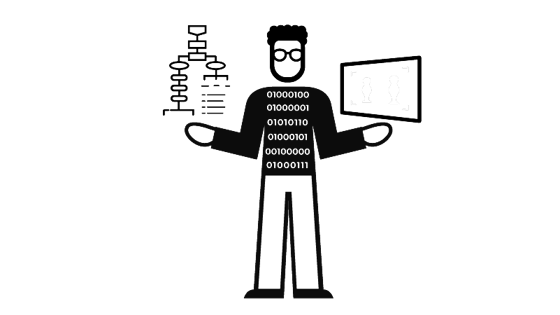Visual effects (VFX)
Software developer
Also known as: Research and development (R&D) programmer

What does a software developer do?
Software developers produce the technology required for a visual effects (VFX) project. They create the systems which technical directors (TDs) can use and modify to suit the specific needs of their VFX artists. They also design new digital tools and make sure they fit into existing software systems. This enables the efficient passing of assets from one VFX process to the next.
This is a research and development role, which means that it involves working out ways to improve how well digital processes works. Software developers must stay informed about software and technology relevant to their field and beyond. They find innovate ways to enable the artists within the pipeline to complete their work as fast and as well as possible.
Read and watch
What's a software developer good at?
- Communication and teamwork: communicate well with pipeline technical directors as well as directly with a variety of staff at different levels to understand their needs and assist with technical issues, work well as part of a team to develop solutions, present a plan to and take direction from supervisors
- Problem-solving: think analytically to come up with creative and efficient solutions, using the most up-to-date technology to find ways to overcome obstacles and achieve a creative vision
- Programming and coding skills: have advanced knowledge of programming in Python and C++ with a very high level of technical ability using a variety of relevant software used across VFX projects, such as Maya, Houdini and Nuke
- Knowledge of all parts of the pipeline: have a strong understanding of all jobs within VFX pipelines, their responsibilities and needs
- Planning: create an appropriate development plan and stick to a timescale, understand how to breakdown a project into tasks
Who does a software developer work with?
Software developers work most closely with technical directors throughout the VFX pipeline.
How do I become a software developer?
To become a software developer, you will need very strong coding skills as well as a detailed understanding of the VFX pipeline. A degree in computer science or a related field is often needed, although the most important thing is a high level of technical skill using coding languages Python and C++. A good route in through an assistant technical director role.
At school or college:
You can take A-levels or Highers in computer science, maths and physics. Or you might want to take any of the following Level 3 vocational qualifications:
- BTEC National Extended Diploma in Creative Digital Media Production
- BTEC National Diploma/Extended Diploma in Computing
If you want to go straight into a job or apprenticeship, the following Level 3 vocational qualifications will equip you:
- Aim Awards Diploma/Extended Diploma in Games Animation and VFX
- BTEC National Diploma in Computing for Creative Industries
- BTEC National Diploma in Film and Television Visual Effects
- OCR Technical Diploma in Digital Media (Digital Content for Interactive Media)
- OCR Technical Diploma in Digital Media (Moving Image and Audio Production)
- UAL Diploma/Extended Diploma in Creative Media Production and Technology
- AQA Technical Level IT: Programming
- OCR Technical Diploma in IT (Digital Software Practitioner)
Get an apprenticeship:
Apprenticeships are jobs with training. They’re a great opportunity to earn while you learn. You might want to enter the VFX industry through an apprenticeship as an assistant technical director. Have a look at NextGen Skills Academy VFX apprenticeships for school leavers. These involve a lot of learning on the job working in a VFX company.
Check out What’s an apprenticeship? to learn more about apprenticeships and find an apprenticeship to learn how to find one in your region, or approach companies directly. Go to ScreenSkills information on VFX apprenticeships for the main apprenticeship schemes in VFX.
Build a portfolio:
If you intend to get into this role through being a VFX artist, you will need to create a portfolio. Learn how to use, and then experiment with, VFX programs and create a showreel that you can show to admissions tutors or employers. Go to build your VFX portfolio to learn how. Watch ScreenSkills’ advice on VFX showreels. It’s really important to develop your appreciation for VFX. Make sure you’re familiar with what’s out there.
Watch a lot of films:
As well as technical skill, it’s really important to develop an appreciation for VFX and animation. Make sure you’re familiar with what’s out there in the industry.
Get a degree:
VFX companies or studios generally prefer it if you have a degree in graphic design, or another VFX-specific course for this role. Have a look at ScreenSkills’ list of recommended courses and select one in VFX. We recognise courses with our ScreenSkills Select award where they offer training in the relevant software, dedicated time to building a portfolio and have strong links with the VFX industry.
Network:
Get to know people in VFX. Check out the events in ScreenSkills training and opportunities directory. Meet professionals and ask them questions about their work, while demonstrating interest and knowledge in the sector. Offer to provide them with your professional contact details and try to stay in touch with them. Go to network well to learn how to do this.
Search for jobs:
Look at the ScreenSkills jobs board. Research VFX companies you’d like to work for. Go to their websites and check if they are advertising for junior roles the art or pre-production departments. Even if they aren’t, send in your CV and showreel and ask them to bear you in mind for future roles or work experience. Keep looking on job websites too. ScreenSkills offers some advice from professionals on how to approach animation and VFX employers.
You might also be interested in...
Being a pipeline technical director (TD) or an effects (FX) TD.






